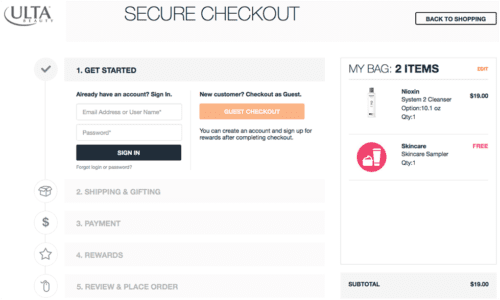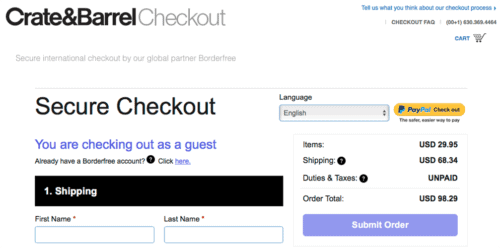The days of shallow or aggressive marketing, poor design and usability, black-hat SEO have gone. Now, consumers are more demanding then ever – because they have a wealth of resources and a number of options.
No one will ever spend their timeand money on boring/ annoying/ complicated websites.
As trends, natural consumer behavior andinteractions with brands go on to evolve, eCommerce retailers need to adapt and appeal to the current buying psychology.
So what really makes customers buy products from you? Here is a perfect combination Lets start.
#1. In the Middle of Google Nowhere?
When people can’t find you, they can’t buy. It doesn’t matter whether you are a Fortune 500 company or a small startup – SEO is crucial for online buying.
Start with on-page SEO: solve duplicate content issues, index the most important pages, properly optimize the amount of meta data, implement HTML/XML sitemaps, rich snippets, breadcrumbs, SEO redirects, etc.
Just as with traditional on-page search optimization, in eCommerce you can’t win without off-page SEO (aka link building – local SEO, guest blogging, etc.).
#2. Professional Product Presentation
If you achievedhigh placement in SERPs, that’sgreat. However, even high rankings won’t guarantee you sales.
The only thing that matters is how many people click on your link in Google and don’t bounce back instantly.
Design eye-catching pages! Create s story-telling atmosphere: use product photography that depicts emotions, shows the perfect environment and the product in context. Help
customers visualize themselves using your items.
#3. Social Proof
The power of social proof is immense. Seeing others engage with your brand creates almost an immediate trust with those who aren’t yet your customers.
All those testimonials, ratings/reviews, influencer endorsements, media logos, subscriber counts, social shares are really important because people trust other people more than they trust merchants.
Even more, online shoppers are more skeptical about the products from the Internet because they’ve never seen these goods before, and they don’t know you and your company. You’ve got it.
People don’t know you, they don’t trust you and won’t trust unless you give them social proof.
#4. Checkout Ease
When shoppers add something to cart, what should happen next? A clear pop-up without reloads with all necessary info about the product. That’s it.
I’m surprised how many sites screw this point up and show somewhat tiny that furthermore
disappears immediately.
Once the product is added to cart, then what?
Forced registration, endless checkout forms, no progress indicators (shows where customers are within the checkout process) are the main reasons for enclosing the checkout.
How to make it great?
First, decide what type can work great for your biz: one-step or multi-page checkout. Then, make it simple:
- Offer a guest checkout, provide an optional social login.
- Keep it short. People hate forms, so don’t ask for too much much information.
- Include security/ trust signals, multiple payment options.
#5. Shipping Transparency
Unexpected shipping costs are the most common reason for shopping cart abandonment. Imagine, your customers find you, see the sign ‘We ship to Your Country’, spend time surfing your store, add the like product to cart and boom! see the shipping costs that are twice as high as the cost of the thing they want. They will leave. Forever.
I will illustrate you my sad example with one store. I spent much time surfing it (as they offered really interesting things), but after I added the products to cart I was unexpectedly disappointed. The reason of my disappointment was that they offered free shipping only for the products priced over $50.
Hence, I’m convinced if there’s no free option, online merchants should show shipping prices as soon as possible.
#6. Order Management
After the an order has been paid for, begins the most import and invisible for the shoppers part. Order management.
Here are the challenges:
- Low efficiency together with manual order processing. According to an APQC study, ‘bottom performers’ need 8 times more to process sales orders than the ‘top performers’.
- Order accuracy. Who wants to get the wrong order and then pay extra for the reselling (I’m not even talk about customer dissatisfaction and loyalty loss).
- Product deliver problems with no way to track the progress of orders.
It all gets on customers nerves. Months of expectations, no reasonable excuses from the merchant, wrong orders received for no orders at all.
To avoid this never-ending nightmare automate the process with a quality solution, like this Magento order management tool or any other.
#7. Responsiveness
Mobile website versions means simplicity: from easy-to-use navigation to the clear checkout process. Optimizing your store for tables and smartphones is a sure-fire way to
reduce bounce rate and enhance customer satisfaction.
Bottom line:
Of course there’s no perfect eCommerce formula suitable for every store. However, there are golden principles that must be implemented primarily. Like these 7 ones. Do you agree with them or there’s something left?
Bio
Natalie Pavlovskaya is a Marketing Executive at MageWorx.Com, developer of Magento plugins. A passionate marketer by day and a copywriter by night, she is here to speak all things ecommerce, UX, digital marketing and social media. The Rolling Stones addict. Follow her on Twitter.
 Gearfuse Technology, Science, Culture & More
Gearfuse Technology, Science, Culture & More









